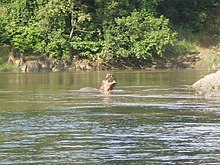Bénoué National Park
| Bénoué National Park | |
|---|---|
 | |
| Location | Cameroon |
| Coordinates | 8°20′N 13°50′E / 8.333°N 13.833°E |
| Area | 1,800 km2 (690 sq mi) |
| Established | 1968 |
Bénoué National Park is a
History
In 1932, the area was established as a Faunal Reserve. It was upgraded to a National Park in 1968, and became a Biosphere Reserve in 1981.[3]
Geography
The park is located in northeastern Cameroon in the
Flora and fauna

The habitat in Bénoué National Park is characterized by wooded grassland. It includes several types of Sudanian woodland such as Isoberlinia-dominated and other woodland in the south-centre, to shorter, more open, mixed wooded grassland in the north, dry Anogeissus forest, semi-evergreen riparian forest and thickets along the Bénoué and its major affluents.
Since 2005, the protected area is considered a Lion Conservation Unit.[7] In 2011, the lion population was estimated at 200 adult individuals.[8][9]
Bénoué National Park is an
Population



The majority of the population within the park is nomadic. There is a loose social structure that park guards and conservationists deal with, taking on roles such as community educators and arbitrators.[1] At least one incident of kleptoparasitism, villagers stealing meat from a lion kill, was documented at Bénoué National Park.[11]
See also
References
- ^ a b c Nchami, John (September 18, 2010). "Putting the park in the hands of the people". Science in Africa. Archived from the original on 29 November 2010. Retrieved 19 September 2010.
- ^ a b c "WILDLIFE NATIONAL PARKS". Consulate of the Republic of Cameroon - Sydney, Australia. Archived from the original on 18 February 2011. Retrieved 19 September 2010.
- ^ a b c d "BirdLife IBA Factsheet CM007 - Bénoué National Park". BirdLife International. Retrieved 19 September 2010.
- ^ ISBN 978-1-84353-118-0.
- ISBN 978-2-8317-0016-8. Retrieved 19 September 2010.
- ISBN 978-2-8317-0418-0.
- ^ IUCN Cat Specialist Group (2006). Conservation Strategy for the Lion West and Central Africa. Yaounde, Cameroon: IUCN.
- .
- .
- ^ "Bird Watching in Cameroon". Archived from the original on 19 September 2010. Retrieved 19 September 2010.
- ^ Walker, M. (2009). "Lions in Cameroon are having their kills stolen from under their noses by hungry villagers". BBC. Retrieved 19 September 2010.
Further reading
- Mayakaa, T. B. (2002). "Wildlife Co-Management in the Benoue National Park-Complex, Cameroon: A Bumpy Road to Institutional Development". World Development. 30 (11): 2001–2016. .
- Mayakaa, T. B.; Stigter, J.D.; Heitkönig, I. M.A.; Prins, H. H.T. (2004). "A population dynamics model for the management of Buffon's kob (Kobus kob kob) in the Bénoué National Park Complex, Cameroon". Ecological Modelling. 176 (1−2): 135–153. .
- Stark, M. A. (1986). "Relationship between fire and basal scarring on Afzelia africana in Benoue National Park". Cameroon African Journal of Ecology. 24 (4): 263–271. .
External links
- BirdLife International. "Important Bird Areas factsheet: Bénoué National Park".



